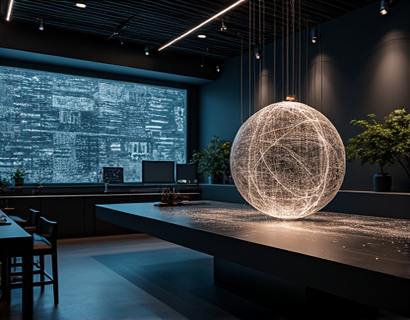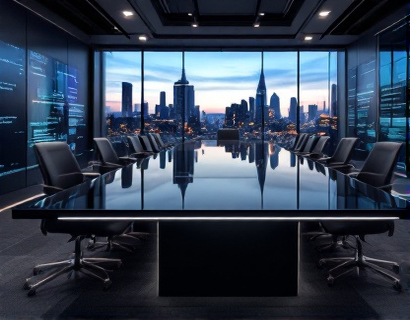Transforming Daily Life with Augmented Reality E-Commerce
In the rapidly evolving landscape of technology, augmented reality (AR) has emerged as a transformative force, particularly in the realm of e-commerce. This innovative approach blends the physical world with digital elements, offering consumers unprecedented ways to interact with products before making a purchase. For tech-savvy individuals seeking to enhance their lifestyle, AR e-commerce presents a compelling opportunity to experience products in a more immersive and personalized manner.
The integration of AR into online shopping platforms has revolutionized the way consumers engage with products. Gone are the days of relying solely on images and descriptions. Today, shoppers can visualize products in their own environment, gaining a deeper understanding of the item's size, color, and functionality. This not only enhances the shopping experience but also reduces the likelihood of returns, benefiting both consumers and retailers.
Understanding Augmented Reality in E-Commerce
Augmented reality in e-commerce involves the use of digital overlays to enhance the real world. These overlays can be viewed through smartphones, tablets, or specialized AR glasses. The technology works by capturing the real-world environment through the device's camera and superimposing virtual objects or information onto the live feed. This seamless integration allows users to see how products would look and function in their actual setting.
For instance, a furniture retailer can offer an AR app that lets customers place virtual sofas or tables in their living room. They can adjust the size, color, and position of the furniture to see which configuration best fits their space. This level of interactivity not only makes the shopping experience more engaging but also more informed, leading to higher customer satisfaction and increased sales.
Benefits of AR E-Commerce for Consumers
One of the most significant advantages of AR e-commerce for consumers is the ability to make more confident purchasing decisions. By visualizing products in their own environment, shoppers can better assess the fit, style, and functionality of items. This reduces uncertainty and the risk of buying something that doesn't meet their expectations.
Additionally, AR enhances the entertainment value of shopping. It turns the often mundane task of online browsing into an interactive and fun experience. Consumers can experiment with different looks and scenarios, which can be particularly appealing for fashion and home decor products. This level of engagement can lead to longer browsing times and a higher likelihood of making a purchase.
Enhanced Product Visualization
Product visualization is a critical aspect of AR e-commerce. High-quality 3D models and realistic rendering techniques ensure that virtual representations of products are as accurate as possible. This attention to detail helps consumers get a true sense of the product's appearance and quality. For example, a clothing brand can use AR to allow customers to see how an outfit would look on them without physically trying it on. This not only saves time but also provides a more personalized shopping experience.
Moreover, AR can provide additional information about products, such as materials, dimensions, and user reviews, all accessible through a simple tap on the virtual item. This enriched information helps consumers make more informed decisions, further enhancing their shopping experience.
AR E-Commerce for Businesses
For businesses, implementing AR into their e-commerce strategy offers numerous benefits. Firstly, it can significantly reduce return rates. By allowing customers to preview products in their own space, businesses can minimize the chances of dissatisfaction and returns. This not only saves costs but also improves the brand's reputation for providing a reliable and customer-friendly service.
AR also provides valuable insights into consumer behavior. By tracking how users interact with virtual products, businesses can gather data on preferences and trends. This information can be used to optimize product offerings, improve marketing strategies, and enhance the overall user experience. For instance, if a particular style of furniture is frequently viewed but not purchased, the business might consider adjusting its inventory or marketing approach.
Increased Customer Engagement
Engagement is key to the success of any e-commerce platform. AR experiences are inherently interactive, which can lead to higher engagement rates. Consumers are more likely to spend time exploring and experimenting with AR features, leading to longer sessions on the website or app. This increased engagement can translate into higher conversion rates and customer loyalty.
Interactive AR demos, virtual try-ons, and gamified shopping experiences are just a few ways businesses can keep customers engaged. For example, a beauty brand could offer an AR makeup try-on feature, allowing users to see how different products and colors look on their face. This not only educates the user but also creates a memorable and enjoyable experience, encouraging them to return to the brand.
Challenges and Considerations
While the benefits of AR e-commerce are clear, there are also challenges that businesses need to address. One of the primary concerns is the technical implementation. Developing a robust AR experience requires significant investment in technology and expertise. Businesses must ensure that their AR applications are user-friendly, compatible with various devices, and provide a seamless experience across different platforms.
Another challenge is the need for high-quality content. The success of AR experiences depends on the accuracy and realism of the virtual representations. Investing in 3D modeling and rendering technologies is essential to create compelling and authentic virtual products. Additionally, businesses must regularly update their AR content to keep up with consumer expectations and technological advancements.
User Privacy and Data Security
With the increased use of AR, user privacy and data security become paramount. AR applications often require access to the user's camera and location data, which raises concerns about how this information is collected, stored, and used. Businesses must be transparent about their data practices and implement strong security measures to protect user information. Building trust in this area is crucial for the adoption and success of AR e-commerce.
Moreover, businesses should consider the accessibility of AR experiences. Not all users may have access to the necessary devices or be familiar with AR technology. Providing clear instructions and support can help bridge this gap and ensure a broader audience can benefit from AR-enhanced shopping.
Future Trends in AR E-Commerce
The future of AR e-commerce looks promising, with several trends poised to shape the industry. One such trend is the integration of AR with other emerging technologies like artificial intelligence (AI) and the Internet of Things (IoT). AI can enhance AR experiences by providing personalized recommendations based on user behavior and preferences. IoT devices can further enrich the AR shopping experience by connecting physical products to virtual information and interactions.
Another trend is the rise of AR in social commerce. Platforms that combine social media with AR shopping experiences are gaining popularity. Users can share their AR experiences with friends, get feedback, and even make purchases directly from the app. This social aspect not only increases engagement but also drives sales through word-of-mouth recommendations.
Enhanced Reality Shopping Environments
As AR technology advances, we can expect to see more immersive and interactive shopping environments. Virtual reality (VR) and AR combined can create entirely new dimensions for online shopping. Imagine stepping into a virtual store where you can explore products in a 3D space, interact with virtual assistants, and even chat with other shoppers in real-time. These enhanced realities can make the online shopping experience as rich and engaging as in-store shopping.
Furthermore, the use of spatial computing and mixed reality (MR) will allow for more seamless integration of digital and physical worlds. Spatial computing involves understanding and interacting with the physical space around us, while MR blends virtual objects with the real world in a more sophisticated way. These technologies will enable more natural and intuitive AR experiences, making it easier for consumers to interact with virtual products.
Conclusion
Augmented reality e-commerce is poised to revolutionize the way we shop, offering a blend of innovation, convenience, and personalization. For tech-savvy consumers seeking to enhance their lifestyle, AR provides a unique and engaging shopping experience that traditional e-commerce cannot match. By leveraging AR, businesses can not only improve customer satisfaction but also gain a competitive edge in the market.
As the technology continues to evolve, the potential for AR in e-commerce is vast. From enhanced product visualization to immersive shopping environments, AR has the power to transform the retail landscape. Embracing this technology is not just a trend but a strategic move towards a more connected and satisfying shopping experience.










































